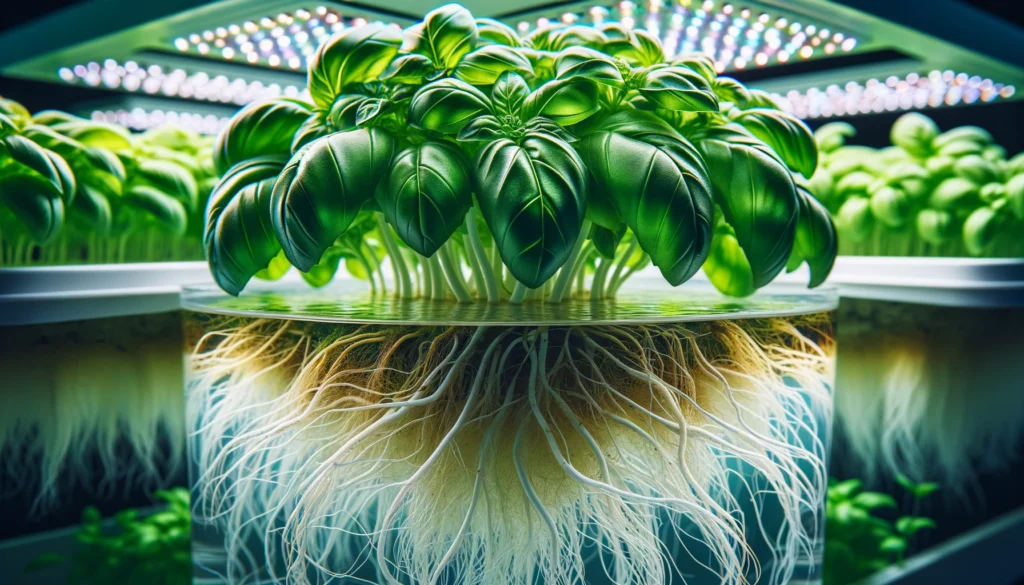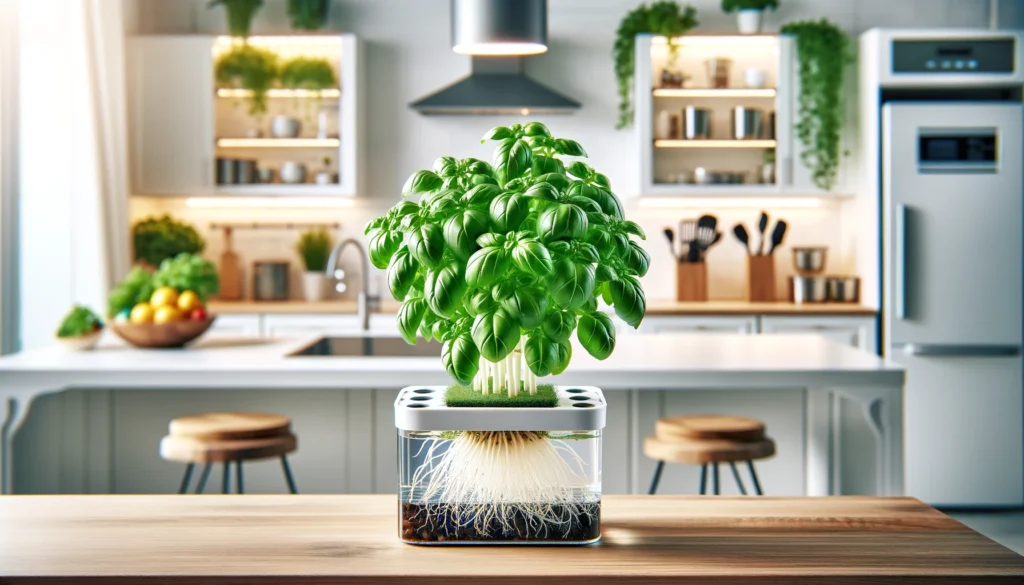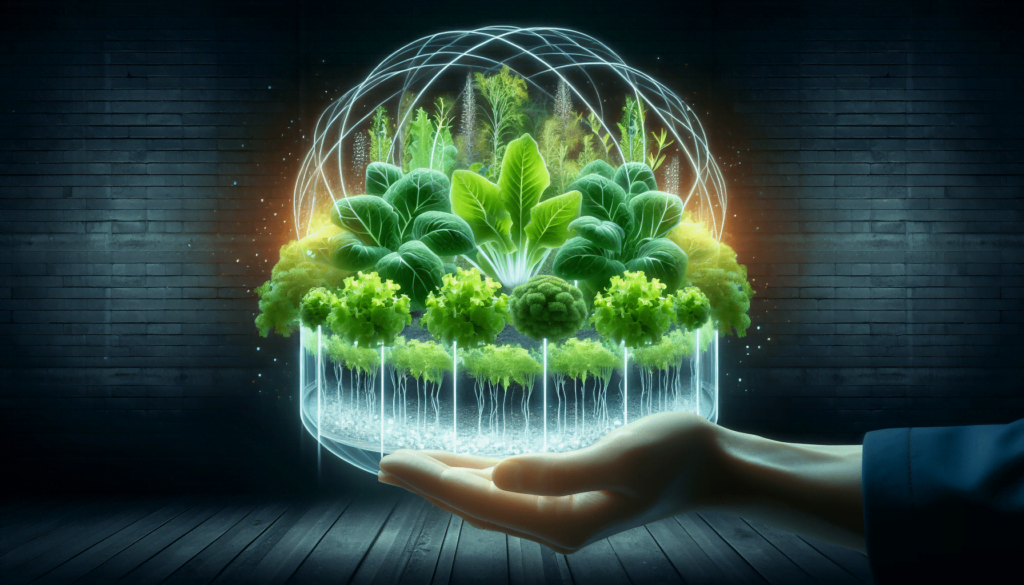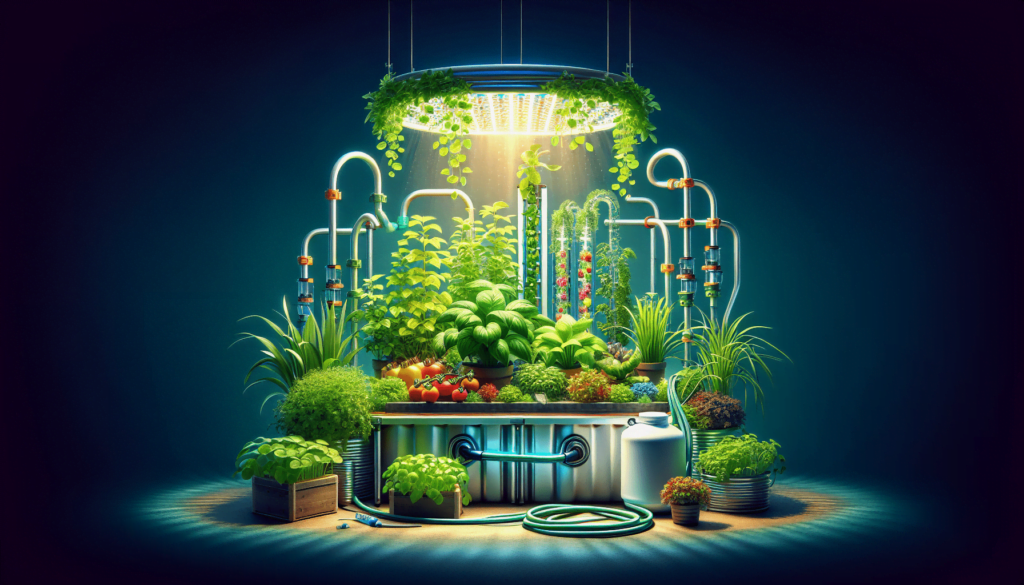Hey there, fellow green thumbs! Are you ready to dive into the world of hydroponic gardening and grow some fantastic basil right at home? Imagine snipping fresh basil leaves right from your kitchen counter while your pasta simmers on the stove. Let’s explore how you can make this a reality with hydroponics!
Why Grow Hydroponic Basil at Home
You might be wondering, why should you bother growing basil hydroponically? Well, let me tell you a little story. My friend Sarah decided to start a hydroponic garden last winter. She was tired of buying basil from the store that always seemed to wilt within a day. Fast forward a few weeks, and she had a thriving basil plant in her kitchen, giving her fresh, aromatic leaves for her homemade pesto. The best part? No soil, no mess, and it grew faster than she could’ve imagined!
Benefits of Growing Hydroponic Basil
- Year-round Growth: No more waiting for the right season. You can grow basil anytime!
- No Soil Needed: Say goodbye to soil-borne pests and diseases.
- Faster Growth: Hydroponic systems provide nutrients directly to the roots, speeding up growth.
- Water Efficiency: Uses less water compared to traditional soil gardening.
- Space-saving: Perfect for small spaces or indoor gardening.
Choosing the Right Hydroponic System
Alright, now that you’re excited about growing your own basil, let’s talk about the best hydroponic systems for home gardeners. There are a few options, each with its own perks.
Best Hydroponic System for Basil
Kratky Method
The Kratky Method is super simple and doesn’t require any pumps or fancy equipment. Just a container, water, and nutrients. Perfect for beginners!
Nutrient Film Technique (NFT)
NFT involves a continuous flow of nutrient solution over the roots. It’s great for small plants like basil and ensures they get all the nutrients they need.
Deep Water Culture (DWC)
In DWC, the roots are submerged in a nutrient-rich solution. This method provides oxygen directly to the roots, promoting faster growth.
Aeroponics
Aeroponics is a bit more advanced, using mist to deliver nutrients to the roots. It’s highly efficient but requires a bit more setup.
Wick System
The Wick System is another passive system where the nutrients are drawn up to the roots through a wick. It’s low maintenance and perfect for busy gardeners.

Factors to Consider
- Space: How much room do you have for your hydroponic system?
- Budget: How much are you willing to invest?
- Experience: Are you a newbie or a seasoned gardener?
- Maintenance: How much time can you dedicate to maintaining the system?
Setting Up Your Hydroponic System
Ready to get your hands a little dirty (metaphorically, of course)? Here’s what you’ll need and how to set it all up.
Materials Needed
- Hydroponic system components (reservoir, pump, growing medium, etc.)
- pH testing kit
- Nutrient solution
- Grow lights (if you’re growing indoors)
Step-by-Step Setup Guide
- Choose and Prepare Your Hydroponic System: Pick your system and set it up according to the instructions.
- Fill the Reservoir: Add water and mix in the nutrient solution.
- Adjust the pH Level: Aim for a pH between 5.5-6.5.
- Set Up Grow Lights: If you’re growing indoors, make sure your basil gets 14-16 hours of light daily.
- Plant Your Basil: Either start from seeds or transplant seedlings into your system.

Choosing the Right Basil for Your Hydroponic Garden
Before you start growing basil hydroponically, it’s important to choose the right variety for your needs. Not all basil is created equal, and different types offer unique flavors, aromas, and growth characteristics. Here’s a guide to help you pick the best basil for your hydroponic garden.
Popular Basil Varieties for Hydroponics
Sweet Basil
- Flavor Profile: Classic, slightly peppery, and sweet flavor.
- Uses: Perfect for pesto, salads, and Italian dishes.
- Growth: Fast-growing and easy to manage, making it a favorite for hydroponic systems.
Genovese Basil
- Flavor Profile: Rich and aromatic with a hint of clove.
- Uses: Ideal for traditional pesto, sauces, and gourmet recipes.
- Growth: Similar to sweet basil but with larger leaves and a more robust flavor.
Thai Basil
- Flavor Profile: Sweet and spicy with anise and licorice notes.
- Uses: Great for Asian cuisine, especially Thai and Vietnamese dishes.
- Growth: Thrives in hydroponic systems with ample light and warmth.
Lemon Basil
- Flavor Profile: Citrus-like with a zesty lemon aroma.
- Uses: Adds a refreshing twist to salads, fish dishes, and desserts.
- Growth: Grows well hydroponically and adds a delightful fragrance to your indoor garden.
Purple Basil
- Flavor Profile: Mild and slightly spicy with a hint of clove.
- Uses: Adds color and flavor to salads, garnishes, and herbal teas.
- Growth: Striking purple leaves make it an attractive addition to any hydroponic setup.
Factors to Consider When Choosing Basil
- Flavor Preferences: Think about what flavors you enjoy most and what types of dishes you cook frequently. Sweet basil is versatile, but if you love Thai food, Thai basil might be a better fit.
- Growth Characteristics: Some basil varieties grow faster or larger than others. Choose a variety that fits well with the size and setup of your hydroponic system.
- Light and Temperature Needs: Ensure that the basil variety you choose matches the light and temperature conditions of your growing space. Most basils thrive with plenty of light and warmth.
- Aesthetic Appeal: If you want your hydroponic garden to be visually appealing, consider varieties like purple basil, which add a pop of color.
Table: Basil Varieties Comparison
| Basil Variety | Flavor Profile | Best Uses | Growth Characteristics |
|---|---|---|---|
| Sweet Basil | Classic, slightly peppery, and sweet | Pesto, salads, Italian dishes | Fast-growing, easy to manage |
| Genovese Basil | Rich, aromatic, hint of clove | Pesto, sauces, gourmet recipes | Larger leaves, robust flavor |
| Thai Basil | Sweet, spicy, anise, licorice | Asian cuisine, Thai, Vietnamese | Thrives with ample light and warmth |
| Lemon Basil | Citrus-like, zesty lemon | Salads, fish dishes, desserts | Grows well, adds fragrance |
| Purple Basil | Mild, slightly spicy, hint of clove | Salads, garnishes, herbal teas | Attractive purple leaves |
Choosing the right basil variety can make a big difference in your hydroponic gardening experience. Whether you’re looking for classic flavors or something a bit more exotic, there’s a basil out there that’s perfect for you.
Nutrient Management for Hydroponic Basil
Your basil needs its nutrients just like we need our morning coffee. Here’s how to keep your plant well-fed.
Hydroponic Basil Nutrient Requirements
Basil needs a mix of essential nutrients: nitrogen, phosphorus, potassium, calcium, magnesium, and sulfur, along with micronutrients like iron, manganese, and zinc.
Mixing and Maintaining Nutrient Solutions
- Use a pre-mixed hydroponic nutrient solution or mix your own.
- Check and adjust the nutrient concentration regularly (look for the right EC levels).
- Change the nutrient solution every 2-3 weeks to keep it fresh.
Light and Temperature Requirements
Basil loves the light and warmth. Here’s how to make sure it gets plenty of both.
Optimal Lighting Conditions
- Types of Grow Lights: LED, fluorescent, or HID lights work great.
- Light Duration: Basil needs 14-16 hours of light per day.
Temperature and Humidity Control
- Temperature: Keep it between 65-75°F (18-24°C).
- Humidity: Aim for 50-70%. Use fans and humidifiers/dehumidifiers to maintain these levels.

Monitoring and Maintenance
Keeping an eye on your basil is key to a healthy, happy plant.
Regular Checks and Adjustments
- Check pH and EC levels regularly.
- Monitor water levels and nutrient solution.
- Inspect your plant for pests and diseases.
Pruning and Harvesting
- Pruning: Regularly prune your basil to encourage bushier growth.
- Harvesting: Snip leaves as needed or cut stems for larger harvests. Early morning is the best time for peak flavor.
Troubleshooting Common Issues
Every gardener hits a bump in the road sometimes. Here’s how to handle common problems.
Common Problems and Solutions
- Yellowing Leaves: Usually a sign of nutrient deficiency or pH imbalance.
- Root Rot: Caused by overwatering or poor oxygenation. Ensure good airflow and proper water levels.
- Pests: Look out for aphids, spider mites, and whiteflies. Organic pest control methods can help.
Preventive Measures
- Clean your system regularly.
- Use organic pest control.
- Ensure good air circulation to keep your plants healthy.
FAQ (Frequently Asked Questions)
- What is hydroponic basil, and how does it differ from soil-grown basil?Hydroponic basil is basil grown using a hydroponic system, where plants are cultivated in a nutrient-rich water solution instead of soil. This method allows for faster growth and higher yields because the plants receive nutrients directly to their roots. Additionally, hydroponic basil tends to be more flavorful and aromatic since the controlled environment can optimize growing conditions.
Forum
Got something to share or a question to ask? Jump in and start a conversation! Whether it’s tips, advice, or just sharing your experiences, we’d love to hear from you. Don’t be shy—your input could inspire or help someone else!All about Hydroponics- This forum has 1 topic, and was last updated 10 months, 2 weeks ago by .
Viewing topic 1 (of 1 total)- Topic
- Voices
- Last Post
Viewing topic 1 (of 1 total)- You must be logged in to create new topics.
Register Here
- What are the benefits of growing basil hydroponically at home?
Growing basil hydroponically at home offers numerous benefits:
- Year-Round Harvest: You can grow basil indoors, ensuring a continuous supply of fresh herbs regardless of the season.
- Faster Growth: Hydroponic systems deliver nutrients directly to the plant roots, accelerating growth rates.
- Pest and Disease Control: The absence of soil reduces the risk of soil-borne pests and diseases, leading to healthier plants.
- Water Efficiency: Hydroponic systems use less water than traditional soil gardening, making them more sustainable.
- Space Saving: Hydroponic setups can be compact and vertical, perfect for small spaces or urban gardening.
Forum
Got something to share or a question to ask? Jump in and start a conversation! Whether it’s tips, advice, or just sharing your experiences, we’d love to hear from you. Don’t be shy—your input could inspire or help someone else!
All about Hydroponics- This forum has 1 topic, and was last updated 10 months, 2 weeks ago by .
Viewing topic 1 (of 1 total)- Topic
- Voices
- Last Post
Viewing topic 1 (of 1 total)- You must be logged in to create new topics.
Register Here
- What equipment do I need to start growing hydroponic basil at home?
To start growing hydroponic basil at home, you’ll need:
- Hydroponic System: Choose from systems like Deep Water Culture (DWC), Nutrient Film Technique (NFT), or Aeroponics.
- Grow Lights: LED grow lights are ideal if you don’t have sufficient natural light.
- Nutrient Solution: A hydroponic nutrient mix specifically designed for herbs.
- Growing Medium: Options include rockwool, clay pellets, or coco coir.
- pH Testing Kit: To monitor and adjust the pH levels of your nutrient solution.
- Water Pump and Air Stone: Essential for systems like DWC to keep the water oxygenated.
Forum
Got something to share or a question to ask? Jump in and start a conversation! Whether it’s tips, advice, or just sharing your experiences, we’d love to hear from you. Don’t be shy—your input could inspire or help someone else!
All about Hydroponics- This forum has 1 topic, and was last updated 10 months, 2 weeks ago by .
Viewing topic 1 (of 1 total)- Topic
- Voices
- Last Post
Viewing topic 1 (of 1 total)- You must be logged in to create new topics.
Register Here
- How do I set up a hydroponic system for growing basil?
Setting up a hydroponic system for basil involves several steps:
- Select Your System: Decide on the type of hydroponic system (DWC, NFT, Aeroponics) based on your space and experience level.
- Prepare the Container: Ensure your container is clean and properly sized for your basil plants.
- Install the Pump and Air Stone: These keep the water oxygenated and circulating.
- Mix the Nutrient Solution: Follow the instructions on your nutrient mix package to prepare the solution.
- Plant the Seeds: Place basil seeds in the growing medium and position them in your system.
- Set Up the Lighting: Position your grow lights to ensure the plants receive adequate light for photosynthesis.
- Monitor and Adjust: Regularly check pH and nutrient levels, and make adjustments as needed.
Forum
Got something to share or a question to ask? Jump in and start a conversation! Whether it’s tips, advice, or just sharing your experiences, we’d love to hear from you. Don’t be shy—your input could inspire or help someone else!
All about Hydroponics- This forum has 1 topic, and was last updated 10 months, 2 weeks ago by .
Viewing topic 1 (of 1 total)- Topic
- Voices
- Last Post
Viewing topic 1 (of 1 total)- You must be logged in to create new topics.
Register Here
- How do I maintain my hydroponic basil plants?
Maintaining hydroponic basil involves regular monitoring and care:
- Check pH Levels: Keep the pH between 5.5 and 6.5 for optimal nutrient absorption.
- Nutrient Levels: Ensure your plants are receiving the right concentration of nutrients by checking the solution weekly.
- Light Exposure: Basil needs about 14-16 hours of light daily. Adjust your grow lights as the plants grow.
- Prune Regularly: Pruning encourages bushier growth and prevents legginess. Pinch off the top leaves to promote lateral growth.
- Clean the System: Regularly clean your hydroponic system to prevent algae buildup and ensure efficient nutrient delivery.
Forum
Got something to share or a question to ask? Jump in and start a conversation! Whether it’s tips, advice, or just sharing your experiences, we’d love to hear from you. Don’t be shy—your input could inspire or help someone else!
All about Hydroponics- This forum has 1 topic, and was last updated 10 months, 2 weeks ago by .
Viewing topic 1 (of 1 total)- Topic
- Voices
- Last Post
Viewing topic 1 (of 1 total)- You must be logged in to create new topics.
Register Here
- What are common problems when growing hydroponic basil and how do I solve them?
Some common problems and their solutions include:
- Yellowing Leaves: Often due to nutrient deficiencies. Adjust your nutrient solution and ensure proper pH levels.
- Slow Growth: Check your light source and nutrient levels. Basil requires adequate light and a balanced nutrient mix.
- Pests: Although less common in hydroponics, pests can still occur. Use organic pest control methods like neem oil or insecticidal soap.
- Root Rot: Caused by poor oxygenation or overwatering. Ensure your water pump and air stone are functioning properly and avoid over-saturating the roots.
Forum
Got something to share or a question to ask? Jump in and start a conversation! Whether it’s tips, advice, or just sharing your experiences, we’d love to hear from you. Don’t be shy—your input could inspire or help someone else!
All about Hydroponics- This forum has 1 topic, and was last updated 10 months, 2 weeks ago by .
Viewing topic 1 (of 1 total)- Topic
- Voices
- Last Post
Viewing topic 1 (of 1 total)- You must be logged in to create new topics.
Register Here
- Can I grow other herbs and vegetables hydroponically alongside basil?
Absolutely! Hydroponics is versatile and allows you to grow a variety of herbs and vegetables. Some compatible plants include mint, parsley, lettuce, spinach, and even cherry tomatoes. Just ensure each plant receives the appropriate light and nutrient levels, and consider their growth habits to avoid overcrowding.
Forum
Got something to share or a question to ask? Jump in and start a conversation! Whether it’s tips, advice, or just sharing your experiences, we’d love to hear from you. Don’t be shy—your input could inspire or help someone else!
All about Hydroponics- This forum has 1 topic, and was last updated 10 months, 2 weeks ago by .
Viewing topic 1 (of 1 total)- Topic
- Voices
- Last Post
Viewing topic 1 (of 1 total)- You must be logged in to create new topics.
Register Here
Conclusion
Growing hydroponic basil at home is not only fun but also super rewarding. Imagine having fresh basil at your fingertips all year round! Plus, you’ll save money and reduce waste. Give it a try and see how much better your homemade dishes can be with fresh, home-grown basil.
We’d love to hear your hydroponic gardening stories! Share your experiences, tips, and even some photos of your basil plants. Join our community of home gardeners and let’s grow together. Subscribe to our newsletter for more tips and tricks, and follow us on social media for the latest updates.
Related Products…
-
%22%20transform%3D%22translate(.6%20.6)%20scale(1.17188)%22%20fill-opacity%3D%22.5%22%3E%3Cellipse%20fill%3D%22%23fffeff%22%20rx%3D%221%22%20ry%3D%221%22%20transform%3D%22matrix(-52.03458%2041.62705%20-31.91965%20-39.90014%20223.7%20234)%22%2F%3E%3Cellipse%20fill%3D%22%23828c48%22%20cx%3D%22177%22%20cy%3D%2263%22%20rx%3D%22116%22%20ry%3D%22116%22%2F%3E%3Cellipse%20fill%3D%22%23b5afd1%22%20rx%3D%221%22%20ry%3D%221%22%20transform%3D%22matrix(-40.55628%2037.75843%20-45.44409%20-48.81144%200%2025.5)%22%2F%3E%3Cellipse%20fill%3D%22%23b3aecd%22%20rx%3D%221%22%20ry%3D%221%22%20transform%3D%22matrix(-32.7702%2032.99978%20-105.72334%20-104.98781%208.7%20230.8)%22%2F%3E%3C%2Fg%3E%3C%2Fsvg%3E) Assortment of 15 Heirloom Non-GMO Herb Seeds for Planting – Over 5200 Seeds for Indoor, Hydroponic, and Outdoor Gardening with Basil, Catnip, Chive, Cilantro, Oregano, Parsley,…$15.26
Assortment of 15 Heirloom Non-GMO Herb Seeds for Planting – Over 5200 Seeds for Indoor, Hydroponic, and Outdoor Gardening with Basil, Catnip, Chive, Cilantro, Oregano, Parsley,…$15.26 -
 12345 Organic Herb Seed Variety Pack for Indoor, Outdoor, and Hydroponic Gardens – Includes Basil, Cilantro, Mint, and Dill Seeds, Non-GMO and USDA Certified Organic$1.02
12345 Organic Herb Seed Variety Pack for Indoor, Outdoor, and Hydroponic Gardens – Includes Basil, Cilantro, Mint, and Dill Seeds, Non-GMO and USDA Certified Organic$1.02 -
%27%20fill-opacity%3D%27.5%27%3E%3Cellipse%20fill%3D%22%23fff%22%20fill-opacity%3D%22.5%22%20rx%3D%221%22%20ry%3D%221%22%20transform%3D%22rotate(-94.3%20109%20104)%20scale(298.18248%2019.35945)%22%2F%3E%3Cellipse%20fill%3D%22%23a9a9a9%22%20fill-opacity%3D%22.5%22%20rx%3D%221%22%20ry%3D%221%22%20transform%3D%22matrix(-28.65458%20-38.33194%2016.24581%20-12.14436%20216.5%20192)%22%2F%3E%3Cpath%20fill%3D%22%23fff%22%20fill-opacity%3D%22.5%22%20d%3D%22M349.1%20312.5l-71%2051.6-56.5-77.7%2071-51.7zM121.3%206L-25.5%2050.7-38%209.3l146.8-44.9z%22%2F%3E%3C%2Fg%3E%3C%2Fsvg%3E) Certified Organic Herb Seeds Variety Pack (10-Pack) – Non-GMO, Heirloom – Includes Basil, Cilantro, Oregano, Thyme, Parsley, Lavender, Chives, Sage, Dill seeds for$9.99
Certified Organic Herb Seeds Variety Pack (10-Pack) – Non-GMO, Heirloom – Includes Basil, Cilantro, Oregano, Thyme, Parsley, Lavender, Chives, Sage, Dill seeds for$9.99
Forum
Got something to share or a question to ask? Jump in and start a conversation! Whether it’s tips, advice, or just sharing your experiences, we’d love to hear from you. Don’t be shy—your input could inspire or help someone else!- This forum has 1 topic, and was last updated 10 months, 2 weeks ago by .
- Topic
- Voices
- Last Post
- You must be logged in to create new topics.






